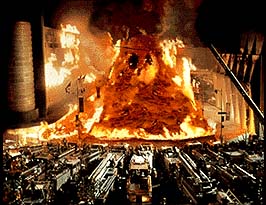![[Metroactive Movies]](/movies/gifs/movies468.gif)
![[Metroactive Movies]](/movies/gifs/movies468.gif)
[ Movies Index | Metro | Metroactive Central | Archives ]
Blowing Off Steam
L.A. gets burned in 'Volcano'
From The Day of the Locust by Nathanael West: "Across the top, parallel to the frame, he had drawn the burning of the city, a great bonfire of architectural styles ranging from Egyptian to Cape Cod colonial." Even in 1939, some were imagining the day L.A. gets its just deserts. This can't be coincidence (film marketers are too shrewd for that), but Volcano was released exactly five years to the week after the L.A. riots. The pleasant surprise isn't just that L.A. looks good under the volcano, it's that director Mick Jackson makes the town look worth saving.
Jackson, who directed a salute to the City of Angels in L.A. Story, stages the spectacular destruction on the handsome Miracle Mile corridor. After a bad earthquake, a volcano rears up from the muck of the La Brea Tar Pits. The film follows Mike Roark (Tommy Lee Jones), head of the Office of Emergency Management, as he organizes a stand against the river of red-hot lava oozing down Wilshire Boulevard. Anna Heche, a pert performer in the Gloria Grahame mold, plays Dr. Amy Barnes, a seismologist who helps and instructs Roark.
Roark's unwhiny daughter, Kelly (Gaby Hoffmann), injured in the blast, is one of the hundreds of patients being tended in the parking lot of Cedars-Sinai hospital, whose unofficial motto, at least when I worked there, was "Where the Stars Go to Die."
Dante's Peak had a leaden tone, as if it were a social protest against vulcanism. Volcano is often serious--a character, immolated during a rescue attempt, is treated with almost spiritual dignity--but the harsher moments are done with a necessary awe. Volcano is a witty but not cynical picture.
Luckily, Jackson gets to have it both ways: a subway conductor is introduced with a shot of a book titled Writing Screenplays That Sell that he holds in his hand, but he dies trying to save his passengers. The TV newscasters aren't easy jokes, either. Seeing them in a line at the Office of Emergency Management follows the theme, established in the titles, of a city where everything is happening at once.
The sound over the titles is a sort of radio-bubble of murmuring electronic broadcasters describing an average disastrous day. The joke in Volcano is not on the broadcasters' kind but on their bad habits.
Jackson cuts to a TV reporter's sad-eyed human-interest story. Amid the amazing chaos, quakes, power failure, lootings and raining ash, the reporter shows us victims of the volcano "who can't tell us where it hurts"--namely, injured pets. One vet is shown bandaging a boa constrictor.
Up until the last 20 minutes during the mandatory climax to the climax, Volcano depicts a burning of L.A. worthy of an artist, with great imagery of spurting fire, palm trees burning like sparklers and gorgeous flowing magma that looks like it might taste good.
Even the burning museums don't seem too tragic. Jackson's image of the burning Folk Art museum is of a huge scowling tribal mask in the display window, flaming like a Martin Denny album cover, and he plays the inside joke of putting a Hieronymus Bosch retrospective at the lava-flooded L.A. Country Art Museum. (Yes, the golden retriever survives again, but at least the paintings do as well.)
Jackson sums up the ambivalence to that infuriating miracle city in two witty lines: Heche's comment, "The city is finally paying for its arrogance," is answered by Jones with, "Which arrogance is that?"
[ Metro | Metroactive Central | Archives ]
This page was designed and created by the Boulevards team.

The Hot Spot: The lava meets the road in "Volcano."
Volcano (PG-13; 104 min.), directed by Mick Jackson, written by Jerome Armstrong and Billy Ray, photographed by Theo van de Sande and starring Tommy Lee Jones and Anne Heche.
Web exclusive to the May 1-7, 1997 issue of Metro